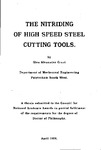THE NITRIDING OF HIGH SPEED STEEL CUTTING TOOLS
| dc.contributor.author | Crust, Glen Alexander | |
| dc.contributor.other | School of Engineering, Computing and Mathematics | en_US |
| dc.date.accessioned | 2013-10-25T11:22:54Z | |
| dc.date.available | 2013-10-25T11:22:54Z | |
| dc.date.issued | 1989 | |
| dc.identifier | NOT AVAILABLE | en_US |
| dc.identifier.uri | http://hdl.handle.net/10026.1/2379 | |
| dc.description.abstract |
There is an interest in industry in cost reduction. Tool wear constitutes an important element in the cost of many metal working processes, not only because of the cost of the tool, but also because of the cost of machine downtime. Saltbath nitriding of high speed steel tools adds only about 1% to the cost of a finished tool, but has been found to confer benefits considerably in excess of this over a range of cutting conditions . A series of cutting tests is described, during which cutting forces and tool temperatures were recorded simultaneously using microcomputer based instrumentation developed at the Polytechnic as part of this study. The shear mechanism for tools with a nose radius is investigated, and methods for evaluating the primary shear plane area are proposed and discussed. The variation in primary shear plane area with chip flow angle is evaluated. The method for predicting chip flow angle from tool geometry is presented, and results from this analysis compared with experimental data . A method for predicting primary shear angle from tool geometry, force measurements and workpiece material properties is developed. A number of methods for measuring tool temperature are described . Temperature distributions obtained from finite element heat transfer analysis are presented, and a mechanism for the catastrophic failure of the toolnose is proposed. A range of cutting conditions is described, over which the performance of high speed steel cutting tools is enhaced by saltbath nitriding. | en_US |
| dc.language.iso | en | en_US |
| dc.publisher | University of Plymouth | en_US |
| dc.title | THE NITRIDING OF HIGH SPEED STEEL CUTTING TOOLS | en_US |
| dc.type | Thesis | |
| dc.identifier.doi | http://dx.doi.org/10.24382/1527 | |
| dc.identifier.doi | http://dx.doi.org/10.24382/1527 |
Files in this item
This item appears in the following Collection(s)
-
01 Research Theses Main Collection
Research Theses Main


